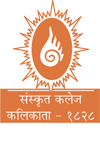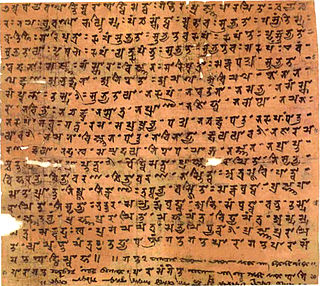Related Research Articles

Devanagari is an Indic script used in the northern Indian subcontinent. Also simply called Nāgari, it is a left-to-right abugida, based on the ancient Brāhmi script. It is one of the official scripts of the Republic of India and Nepal. It was developed and in regular use by the 8th century CE and achieved its modern form by 1200 CE. The Devanāgari script, composed of 48 primary characters, including 14 vowels and 34 consonants, is the fourth most widely adopted writing system in the world, being used for over 120 languages.

Sanskrit is a classical language belonging to the Indo-Aryan branch of the Indo-European languages. It arose in South Asia after its predecessor languages had diffused there from the northwest in the late Bronze Age. Sanskrit is the sacred language of Hinduism, the language of classical Hindu philosophy, and of historical texts of Buddhism and Jainism. It was a link language in ancient and medieval South Asia, and upon transmission of Hindu and Buddhist culture to Southeast Asia, East Asia and Central Asia in the early medieval era, it became a language of religion and high culture, and of the political elites in some of these regions. As a result, Sanskrit had a lasting effect on the languages of South Asia, Southeast Asia and East Asia, especially in their formal and learned vocabularies.
Pāli, also known as Pali-Magadhi, is a Middle Indo-Aryan liturgical language on the Indian subcontinent. It is widely studied because it is the language of the Buddhist Pāli Canon or Tipiṭaka as well as the sacred language of Theravāda Buddhism.
The Oxford Centre for Hindu Studies, founded in 1997 and based in Oxford, England, is a research academy focused on the study and teaching of Hindu cultures of India and Nepal. It develops academic programmes of education, research and publishing in Hindu studies. It aims to encourage the Hindu community in the academic study of their own traditions and cultures. Till 2020, it functioned as a "recognised independent center" under the University of Oxford.

Manipravalam is a macaronic language found in some manuscripts of South India. It is a hybrid language, typically written in the Grantha script, which combines Sanskrit lexicon and Tamil morpho-syntax. According to language scholars Giovanni Ciotti and Marco Franceschini, the blending of Tamil and Sanskrit is evidenced in manuscripts and their colophons over a long period of time, and this ultimately may have contributed to the emergence of Manipravalam. However, the 14th century Sanskrit work Lilatilakam states that Manipravalam is a combination of Tamil and Sanskrit. Generally, it is agreed that it was a combination of Middle Tamil and Sanskrit.

Tigalari, also known as Tulu script, is a Southern Brahmic script which was used to write Tulu, Kannada, and Sanskrit languages. It was primarily used for writing Vedic texts in Sanskrit. It evolved from the Grantha script. It is referred to as Tigalari lipi in Kannada-speaking regions and Tulu speakers call it as Tulu lipi. It bears high similarity and relationship to its sister script Malayalam, which also evolved from the Grantha script.

Sanskrit College and University is a state university located in Kolkata, West Bengal, India. It focuses on liberal arts, offering both UG and PG degrees in Ancient Indian and world history, Bengali, English, Sanskrit, Linguistics, and traditional orientation learning except Pali in which only UG degree is being offered.
Fort William College was an academy of oriental studies and a centre of learning, founded on 18 August 1800 by Lord Wellesley, then Governor-General of British India, located within the Fort William complex in Calcutta. Wellesley started the Fort William College to train the European administrators. He backdated the statute of foundation to 4 May 1800, to commemorate the first anniversary of his victory over Tipu Sultan at Seringapatam. Thousands of books were translated from Sanskrit, Arabic, Persian, Bengali, Hindi, and Urdu into English at this institution.

Sampurnanand Sanskrit Vishwavidyalaya is an Indian university and institution of higher learning located in Varanasi, Uttar Pradesh. It is one of the largest Sanskrit universities in the world. Currently university offers a range of undergraduate and postgraduate programs in various disciplines. The university has been accredited by NAAC and recognized by UGC.

Bhagirath Prasad Tripathi, better known as Vagish Shastri, was an Indian Sanskrit grammarian, linguist, tantra and yogi. In 2018, Government of India awarded him the fourth highest civilian award Padma Shri for his work in the field of literature and education.

Palm-leaf manuscripts are manuscripts made out of dried palm leaves. Palm leaves were used as writing materials in the Indian subcontinent and in Southeast Asia dating back to the 5th century BCE. Their use began in South Asia and spread to other regions, as texts on dried and smoke-treated palm leaves of the Palmyra or talipot palm. Their use continued until the 19th century when printing presses replaced hand-written manuscripts.
Lakshman Shastri Joshi was an Indian scholar, of Sanskrit, Hindu Dharma, and a Marathi literary critic, and supporter of Indian independence. Mahatma Gandhi chose him to be his principal advisor in his campaign against untouchability. Joshi was the first recipient of Sahitya Akademi Award in year 1955. He was also awarded with two of the India's highest civilian honours Padma Bhushan in 1973 and Padma Vibhushan in 1992
Durgasimha was the minister of war and peace of Western Chalukya King Jayasimha II. Durgasimha adapted the well-known set of fables, Panchatantra, from Sanskrit language into the Kannada language in champu style. The Kannada-language version, whose central theme has a strong Jain bent, contains 60 fables, 13 of which are original stories. All the stories have morality as their theme and carry a summary section. The Kannada version is the earliest Indian vernacular version, and the author, being a minister, not surprisingly, chose to write a book on political science (Rajniti). The scholar R. Narasimhachar fixed the date of this work as c. 1025, but the modern Kannada poet and scholar Govinda Pai dated the work to 8 March 1031, based on information in the concluding stanza of the manuscript.

Sooranad P. N. Kunjan Pillai was an Indian researcher, lexicographer, poet, essayist, literary critic, orator, grammarian, educationist, and scholar of the Malayalam language, best remembered for his contributions in compiling Malayala Maha Nighantu, a lexicon. The Government of India awarded him the fourth highest civilian honour of the Padmashri in 1984 for his contribution to Malayalam literature and education. He was also a recipient of the Vallathol Award in 1992 and when the Government of Kerala instituted the Ezhuthachan Puraskaram, their highest literary honour in 1993, he received the inaugural award.

Vishwanathan Venkatachalam was an eminent Sanskrit scholar. He served as the vice-chancellor of Sampurnanand Sanskrit University, Varanasi, India for two terms. He was awarded the Padma Shri in 1989 by the Government of India for his valuable contribution to the field of Sanskrit research and education.

Krishna Venkateswara Sarma (1919–2005) was an Indian historian of science, particularly the astronomy and mathematics of the Kerala school. He was responsible for bringing to light several of the achievements of the Kerala school. He was editor of the Vishveshvaranand Indological Research Series, and published the critical edition of several source works in Sanskrit, including the Aryabhatiya of Aryabhata. He was recognised as "the greatest authority on Kerala's astronomical tradition".
Nalini Balbir is a French Indologist who lives in Paris. She is a scholar of Sanskrit, Prakrit, Pali, Jainism, Buddhism and Hinduism. She was previously a student of Indologist Colette Caillat. She is known for her work on the publication of the Catalogue of the Jain Manuscripts of the British Library published by the Institute of Jainology.
Venkataraman Raghavan (1908–1979) was a Sanskrit scholar and musicologist. He was the recipient of numerous awards, including the Padma Bhushan and the Sahitya Akademi Award for Sanskrit, and authored over 120 books and 1200 articles.

Bhaiksuki is a Brahmi-based script that was used around the 11th and 12th centuries CE. It used to be known in English as the "Arrow-Headed Script" or "Point-Headed Script," while an older designation, "Sindhura," had been used in Tibet for at least three centuries. Records showing usage of the script mainly appeared in the present-day states of Bihar and West Bengal in India, and in regions of Bangladesh. Records have also been located in Tibet, Nepal, and Burma.

Sanskrit Buddhist literature refers to Buddhist texts composed either in classical Sanskrit, in a register that has been called "Buddhist Hybrid Sanskrit", or a mixture of these two. Several non-Mahāyāna Nikāyas appear to have kept their canons in Sanskrit, the most prominent being the Sarvāstivāda school. Many Mahāyāna Sūtras and śāstras also survive in Buddhistic Sanskrit or in standard Sanskrit.
References
- ↑ Kamla Kanta Mishra (1997), Sanskrit Studies in India: On the Occasion of 10th World Sanskrit Conference, Bangalore, Jan 3-9, 1997, pp. 284
- ↑ Ministry of Education, India (1937), Progress of Education in India, P. 215
- ↑ Proceedings and Transactions of the All-India Oriental Conference, Volume 18, Part 1955 (1955),